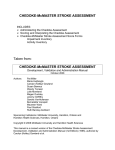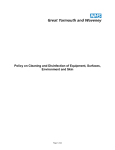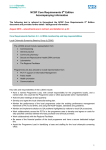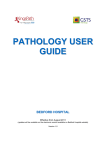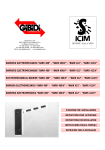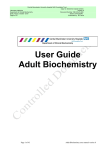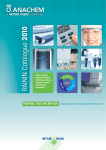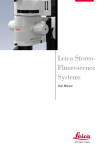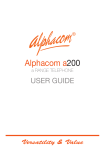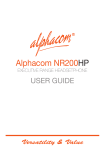Download Microbiology User Guide - Central Manchester University Hospitals
Transcript
Trafford Healthcare NHS Trust Department of Pathology Microbiology User Guide Document DOC 129 Version 3 Microbiology User Guide Location of Microbiology Department............................................................2 Opening Hours..............................................................................................2 Contacts........................................................................................................2 Introduction ...................................................................................................3 Infection Control............................................................................................3 Collection of Specimens ...............................................................................3 Storage of specimens ...................................................................................4 Inoculation Risk and High risk specimens.....................................................4 Identification Criteria .....................................................................................5 Specimen Information/Containers/Transport Media......................................6 Transport to the laboratory............................................................................6 Requesting Urgent Tests ..............................................................................7 Requesting additional tests...........................................................................7 Results and reports.......................................................................................8 Clinical advice ...............................................................................................8 Microbiology on-call service..........................................................................8 Specimen collection ......................................................................................9 DETAILED REQUIREMENTS OF SPECIMENS FOR MICROBIOLOGICAL INVESTIGATION ..............................................9 References..................................................................................................19 The master copy of the current version of this document is held in Q-Pulse. Printed copies (provided they are current versions) may be retained for use where Q-Pulse is inaccessible Page 1 of 19 Trafford Healthcare NHS Trust Department of Pathology Microbiology User Guide Document DOC 129 Version 3 Location of Microbiology Department The department is situated on the upper floor of the Pathology Building, at the rear of the Hospital. Specimen Reception is on the lower floor. Opening Hours 8.45am - 5.00pm Mon-Fri 8.45am – 12.30pm Sat Biomedical Scientist on call at all other times (through hospital switchboard) Contacts Dr Barzo Faris 0161 746 2469 Consultant Microbiologist (or pager via switchboard) Secretary Mr. Wayne Goddard 0161 746 2471 0161 746 2639 Consultant Biomedical Scientist Mrs. Pauline Westbrook Head BMS 0161 746 2477 0161 746 2467 Main Laboratory Main Pathology Reception 0161 746 2466 0161 746 2495 The master copy of the current version of this document is held in Q-Pulse. Printed copies (provided they are current versions) may be retained for use where Q-Pulse is inaccessible Page 2 of 19 Trafford Healthcare NHS Trust Department of Pathology Microbiology User Guide Document DOC 129 Version 3 Introduction It is important that Essential Information is recorded in the Microbiology section of the multidisciplinary request form, as outlined in the “Identification Criteria” - Page 5 below and so as to comply with the current Pathology User Guidelines. Include relevant details such as main clinical conditions and symptoms, date of onset, history of travel, animal contact and date of exposure to infectious disease or needlestick injury. Include recent/current/imminent antibiotic and relevant immunisation history. The date of onset of the illness is essential for specimens requiring virology or serology investigations If unsure about which test, type of specimen, or when/how to collect it, please telephone the laboratory Infection Control The Consultant Microbiologist and Infection Control Nurses give advice on MRSA All aspects of infection prevention and control Outbreaks Decontamination of medical equipment Disinfectant choice Waste disposal Foreign travel via TRAVAX Remember that Your ‘5 moments’ for hand hygiene is the most effective way to prevent the spread of infection. http://www.who.int/gpsc/5may/background/5moments/en/index.html Collection of Specimens Material for the attempted isolation or detection of bacteria, fungi, parasites or viruses should be collected as early as possible in the illness, preferably before the start of antimicrobial therapy, and should be as representative as possible. All specimens should be secured in leak-proof containers, in transport media where appropriate, and transported to the laboratory in sealed bagged forms. Patient details, clinical details and investigation sought should be clearly visible. Request forms should be signed by the medical practitioner and the surgery address indicated using the practice ‘Telepath Code’ or rubber stamp. The master copy of the current version of this document is held in Q-Pulse. Printed copies (provided they are current versions) may be retained for use where Q-Pulse is inaccessible Page 3 of 19 Trafford Healthcare NHS Trust Department of Pathology Microbiology User Guide Document DOC 129 Version 3 Storage of specimens Specimens should preferably reach the laboratory within two - four hours of collection. If there is to be a delay e.g. Overnight specimens should be stored as follows: Room Temperature: Microbiology swabs in transport media. CSF samples must be transported immediately to the laboratory and the laboratory staff informed. Samples should not be refrigerated as this may compromise the recovery of fragile organisms Chlamydia samples once in transport media may be stored between 2°C and 30°C and tested within 30 days of collection. Fridge: (Not a fridge used for the storage of food, drink, drugs or medical devices ) Urines, faeces, sputa, fluids, clotted blood, viral transport media and Chlamydia transport media Incubator: Blood culture specimens taken outside normal laboratory hours should be placed in the incubator in Pathology reception with the request form. Specimens that are delayed and have not been stored correctly may not be processed. A comment will be added to the report to suggest that the results may be compromised due to the incorrect storage or delay in receipt from collection time. Inoculation Risk and High risk specimens Any specimen from a patient known or suspected to have an infection with a bloodborne virus such as HIV, Hepatitis B or C infection should have an ‘Inoculation Risk’ label attached to the specimen and the request form. Great care must be taken in obtaining specimens. Equipment such as needles and blades must be immediately disposed of safely in approved "sharps" boxes and never sent to the laboratories. For pyrexial patients presenting within 3 weeks of arriving from a viral haemorrhagic fever endemic region, malaria should be excluded as per policy ( a risk assessment must be undertaken before sending) and then the case discussed with a Consultant Microbiologist via switchboard before submitting any further samples to any laboratory or admitting the patient. The master copy of the current version of this document is held in Q-Pulse. Printed copies (provided they are current versions) may be retained for use where Q-Pulse is inaccessible Page 4 of 19 Trafford Healthcare NHS Trust Department of Pathology Microbiology User Guide Document DOC 129 Version 3 Specimens should be transported to the laboratory as rapidly as possible after collection to allow for the most accurate interpretation of results. Always ensure that the packaging and method of transport complies with the regulations (see below). A request form must accompany all specimens sent to the laboratory. It should clearly state the following information for unequivocal identification of the patient and specimen: Identification Criteria A request form must accompany all specimens sent to the laboratory. If the laboratory cannot unequivocally identify the sample and match it to a form, then it will be discarded after recording any details available. Please note that unlabelled specimens cannot be processed and will be discarded. The information required on any sample and accompanying form in order to make an unequivocal identification of the patient and their sample(s) is as follows: Essential Sample Desirable Patients full name or correctly coded Time sample taken (sometimes essential) identification Hospital or NHS Number Date of Birth Date collected Request Form Patients full name or correctly coded identification Clinicians bleep No Date of birth Patients address Sex of patient All relevant clinical details including any antimicrobial treatment (recent, current and intended) Report destination Requesting Consultant or GP (including computer code) Requesting Clinician Date collected Electronic record or NHS number Type of specimen Investigation required Signature of requesting Clinician Time collected All relevant clinical details including any antimicrobial treatment (recent, current and intended) Date of onset and duration of illness, particularly for serology Specify anatomical site from "wound" specimens were taken Risk status, if applicable and History of foreign travel including return dates where samples are potentially “HIGH RISK”. The master copy of the current version of this document is held in Q-Pulse. Printed copies (provided they are current versions) may be retained for use where Q-Pulse is inaccessible Page 5 of 19 which Trafford Healthcare NHS Trust Department of Pathology Microbiology User Guide Document DOC 129 Version 3 If uncertain about the exact test and terminology, please give a detailed clinical history as this can help the medical staff to decide the most appropriate investigations EPR barcode stickers: please try to ensure that the sticker is placed on the specimen container in such an orientation that it can be read by a bar code reader. Specimen Information/Containers/Transport Media Specimen containers Leaking specimens, or those received in inappropriate containers, may not be processed (although the laboratory will try to recover leaking unrepeatable samples). The following are the usual containers used to collect specimens: Blood culture sets: keep bottles of a set together and return any unused bottles. Ensure the stock is used in turn and always within its expiry date. Please do not detach the barcode labels on the bottles. Dermapak Black card for superficial fungal specimens (scraping, hair etc) 60 ml wide mouth pots for faeces, sputum and urine specimens Pernasal swab with blue top and charcoal media for whooping cough Urine and swab Chlamydia collection kits Viral swab collection kits Swabs with charcoal bacteriological transport medium - store at room temperature Swabs with fine head, orange topped and clear transport media for aural swabs Sterile 30ml universals for CSF and other fluids Transport to the laboratory Pneumatic Air Tube Transport System The following ‘microbiology’ specimens must not be sent via the air tube: any respiratory tract specimen (sputum, pleural fluid, bronchoalveolar lavage, aspirates etc) any specimen sent for mycobacterial (TB) culture any specimen from patients know to have, or thought to have: - transmissible spongiform encephalopathy (CJD, GSS etc) - a viral haemorrhagic fever (eg Lassa, Ebola etc) any unrepeatable specimen of any type blood culture sets (the bottles almost invariably break) The master copy of the current version of this document is held in Q-Pulse. Printed copies (provided they are current versions) may be retained for use where Q-Pulse is inaccessible Page 6 of 19 Trafford Healthcare NHS Trust Department of Pathology Microbiology User Guide Document DOC 129 Version 3 Specimen carriers Some areas of the hospital are served by porters who will carry samples to the laboratory but where this service is not available, it is essential that anyone carrying samples to the laboratory does so in accordance with the published laboratory guidelines - P04-005-F5 – “Guidelines for laboratory porters and messengers (including all staff carrying or handling samples for the laboratory)”. Specific laboratory containers (sealed red boxes) are provided for the safe transport of specimens to the laboratory from within the hospital, so samples must not be carried in the hand or in a pocket. Pathology and / or PCT transport services will collect samples from the PCT and other local hospitals on a daily basis. Requesting Urgent Tests During normal working hours The laboratory will require a telephone call to alert them that an urgent sample is on its way to the department. The request form should contain the bleep number of the requesting doctor for communicating the initial results The request form should be marked urgent Outside normal working hours Refer to Microbiology on-call service below: Requesting additional tests The microbiological value of specimens - especially those from non-sterile sites usually deteriorates with time as significant bacteria may die-off, or be overgrown by clinically insignificant contaminants. Generally, requests for additional tests on a specimen should be made to the laboratory on the day the specimen is submitted. Although most specimens are kept for approximately 48 hours, for easily collected material (eg urine, superficial swab etc) it is better to send a fresh specimen and request the additional investigation(s). However, specimens of sterile fluids (eg CSF, ascites, synovial fluid etc) and tissues are refrigerated after initial analysis and kept for 14 days. Additional investigation of such specimens may be warranted and clinically helpful: additional tests should be discussed with the Microbiology Consultant. The master copy of the current version of this document is held in Q-Pulse. Printed copies (provided they are current versions) may be retained for use where Q-Pulse is inaccessible Page 7 of 19 Trafford Healthcare NHS Trust Department of Pathology Microbiology User Guide Document DOC 129 Version 3 Results and reports Printed results All positive results are authorised for printing following release by a Consultant Medical Microbiologist. Reports for Primary Care are dispatched every working day, Monday to Friday. Apart from negative urines, which can be reported after one working day, most Microbiology culture results are reported after 2-5 days, depending on the investigation. Copies of printed reports can be obtained upon request but reports are never faxed Telephoned results Results of urgent requests (and results where the clinical information suggests that they may immediately impact on patient management) will be telephoned to the requesting doctor or, in some cases, to the senior ward or clinic nurse. This includes all positive blood cultures and positive CSF results. Results of epidemiological importance are telephoned whenever possible. Clinical advice A Medical Microbiologist and consultant BMS is available from 9:00 to 17:00, Monday to Friday on extension 2469 or 2639. Advice on prophylaxis and the treatment of infections is available in the Antibiotic Policy available via the Intranet. Out of hours (17.00 – 09.00) Clinical Medical Microbiology advice are available via the Trust switchboard to discuss clinical, diagnostic and therapeutic problems with doctors at any time. During the day, infection control advice can be obtained from the IP&C teams and Intranet policies or from the Infection Control Nurses. Out-of-hours service is available from the Medical Microbiologist Specialist Registrar or Consultant via the Trust switchboard Microbiology on-call service The Biomedical Scientist on-call service operates outside normal laboratory opening hours for urgent samples only. The requesting clinician will telephone the hospital switchboard for the service The service is restricted to fluids from sterile sites where the results of a gram stain will alter the management of the patient at the time of request. Any other requests for calling the BMS into the hospital must be approved by the Consultant Microbiologist via the hospital switchboard The master copy of the current version of this document is held in Q-Pulse. Printed copies (provided they are current versions) may be retained for use where Q-Pulse is inaccessible Page 8 of 19 Trafford Healthcare NHS Trust Department of Pathology Microbiology User Guide Document DOC 129 Version 3 Specimen collection The best results are obtained when an appropriate, well-taken specimen is in the proper container, is delivered to the laboratory promptly and relevant clinical information provided on the request form. General guidelines on specimen collection are: Do not send specimens in non-sterile containers or flip-top containers. Collect specimens from the actual site of suspected infection. Please do not send blood samples with very general requests such as ‘viral serology’ when the best sample may be vesicular fluid, throat swab or CSF. The specimen taken should be representative of the disease process. For example, material swabbed from the opening of a sinus tract is more likely to yield commensal micro-organisms on the skin than would material obtained by curettage or biopsy of the base of the tract Specimens should be obtained before antimicrobial agents have been administered wherever possible An adequate quantity of material should be obtained for complete examination. Always send pus rather than a swab of pus, if possible. Swabs should always be in transport medium rather than dry. Care must be taken to avoid contamination of the specimen by micro organisms normally found on the skin and mucus membranes. Sterile equipment and aseptic technique must be used for collecting specimens, particularly for those from normally sterile sites. Material must be transported promptly to the laboratory. Fastidious organisms may not survive prolonged storage or may be overgrown by less fastidious organisms before culturing Please contact the laboratory if there is any doubt about the best specimen to take or if you have questions about the availability of a test. DETAILED REQUIREMENTS OF SPECIMENS FOR MICROBIOLOGICAL INVESTIGATION Antimicrobial Assays Antimicrobial assays for Vancomycin and Gentamicin are performed in Chemical Pathology. Please refer to the Antibiotic Policy for further information. Antral washings Ideally an ENT surgeon should collect the specimen. Transfer to a sterile universal container. Ensure the cap is tightly screwed on. The master copy of the current version of this document is held in Q-Pulse. Printed copies (provided they are current versions) may be retained for use where Q-Pulse is inaccessible Page 9 of 19 Trafford Healthcare NHS Trust Department of Pathology Microbiology User Guide Document DOC 129 Version 3 Aspirates and fluids from normally sterile sites Collect the specimen with a sterile syringe. Transfer a maximum of 20ml into a sterile universal container. Ensure the cap is tightly screwed on. Ascitic fluids may also be inoculated at the patient’s bedside directly in to a blood culture set (using ANTT). Blood Cultures There is a separate procedure for the taking blood cultures. Bronchial washings After collection remove the cap and the tubing of the sterile suction container and apply the screw cap to the container. Bronchoalveolar lavage A specialist physician will collect the specimen in a sterile container according to local protocol. Traps containing a specimen should be sealed using a loop of tubing. Cerebrospinal fluid Suspected meningitis An adequate amount is essential - send at least 2-3ml in at least 2 sterile universals. This is particularly important if Mycobacterium tuberculosis infection is suspected where small numbers of organisms may be present: please send a minimum of 6 ml for MTB. The results of microscopy and any positive cultures are always telephoned. A fluoride oxalate sample processed in Chemical Pathology is also collected for examination of Glucose Suspected Subarachnoid haemorrhage (SAH) If there is a clinical suspicion of SAH and the specimen is bloodstained send 3 separate CSF samples clearly labelled with number 1, 2 or 3. Send all samples to Microbiology so that a differential red blood cell counts may be performed. The results of microscopy and any positive cultures are always telephoned. Always inform the laboratory that SAH is a possibility by providing the differential diagnoses. NB: Xanthochromia. Please refer to the specific requirements in the “Chemical Pathology User Guide” – DOC 116 for sample collection Chlamydia Collection kits are available from the laboratory with specific collection instructions on the package. Ear swab An orange coloured swab case with a fine wire stick in clear transport media is used. Place the swab in the ear canal. Rotate gently. Place the swab in the plastic transport sheath The master copy of the current version of this document is held in Q-Pulse. Printed copies (provided they are current versions) may be retained for use where Q-Pulse is inaccessible Page 10 of 19 Trafford Healthcare NHS Trust Department of Pathology Microbiology User Guide Document DOC 129 Version 3 Eye swab Microbiology (bacteriology): Gently evert the lower eyelid to expose the conjunctival membrane. Use a swab in charcoal transport media. Rub the swab gently over the conjunctival membrane avoiding the cornea. Place the swab in the plastic transport sheath. Chlamydia: Take this after the Microbiology specimen. The intracellular pathogen inhabits columnar epithelial cells not pus. The baby's head should be immobilised and the lower eyelid everted to expose the inferior conjunctival palpebrae. The sampling swab should be pressed against the conjunctiva and rubbed along its length. The swab should then be broken/ cut off into the transport media provided. The lid of the container should be securely fixed to prevent leakage. The container should be labelled before sealing in the specimen transport bag/request form. The specimen should be delivered to the laboratory as soon as possible. If there is to be a delay of longer than 48 hours the specimen should be refrigerated. Virology: Moisten the swab in sterile saline before taking the specimen (never moisten the swab in viral transport medium). Follow procedures as for the Microbiology swab. Snap off the swab tip into viral transport medium Faeces Send a "plum-sized portion" or 5-10ml if liquid in a 60ml sterile universal. Ask the patient to defecate into a clean bedpan or other convenient container if at home and transfer to the sterile universal. Take care not to contaminate the outside of the faeces pot. Faeces samples for Clostridium difficile should be sent as soon as possible following the onset of diarrhoea. Please refer to C. difficile Policy. Amoebic dysentery - for examination of amoebic trophozoites the specimen must reach the laboratory within 1 hour of its production. It is advisable to arrange this examination with the laboratory in advance. For all investigations, if more than one specimen is to be submitted, ensure that these are obtained on successive days. Investigation of threadworms The specimen of choice is a saline swab that is rubbed around the anus early in the morning. The swab is broken off into the 5ml saline container and sent to the laboratory with the request form. A guide sheet is sent out to the patient with the saline pot and sterile swab. Genital tract swabs Cervical and high vaginal swabs must be taken with the aid of a speculum. It is important to avoid vulval contamination of the swab. For Trichomonas, swab the posterior fornix. If there are obvious candida plaques swab the lesions. If pelvic infection, including gonorrhoea, is suspected, swab the cervical os. For Chlamydia trachomatis investigations send a cervical swab in Chlamydia transport medium. Place the swab in chlamydia transport medium, snip off the shaft and screw the cap on. If herpes simplex is suspected send an additional swab. Moisten the swab in sterile saline before taking the specimen. Never moisten swab in VTM. Follow procedures as for the Microbiology swab. Snap off the swab tip into viral transport medium The master copy of the current version of this document is held in Q-Pulse. Printed copies (provided they are current versions) may be retained for use where Q-Pulse is inaccessible Page 11 of 19 Trafford Healthcare NHS Trust Department of Pathology Microbiology User Guide Document DOC 129 Version 3 Cervical swabs: Microbiology: introduce the speculum; roll the swab in the endocervix. Place the swab in the plastic transport sheath containing the black charcoal-containing Amies medium. For the investigation of Chlamydia use a Chlamydia swab and chlamydia transport medium. Place the swab in chlamydia transport medium, snip off the shaft and screw the cap on. Send a swab in virus transport medium for virology if needed. High vaginal swabs: Introduce the speculum. Roll the swab firmly over the surface of the vaginal vault. Place the swab in the plastic transport sheath containing the black charcoal-containing Amies medium. Urethral swabs: Avoid contamination with micro-organisms from the vulva or the foreskin. Small swabs are available for this purpose. The patient should not have passed urine for at least 1 hour. For males, if discharge is not apparent attempt to "milk" it out of the penis. Pass the swab gently through the urethral meatus and roll around. Place the swab in the plastic transport sheath containing the black charcoalcontaining Amies medium. Chlamydia: Take this specimen after the Microbiology swab. Pass the swab through the urethral meatus and gently but firmly roll it over all the surfaces of the urethral epithelium for 1-2 seconds then withdraw. Place the swab in chlamydia transport medium, snip off the shaft and screw the cap on. Helicobacter Stool antigen testing has replaced serology for diagnosis of Helicobacter infection. A plum sized sample is collected into a 60ml sterile universal. Detection of antigen in stool provides direct evidence of current infection with reported sensitivities and specificities of >90%. However, it should be noted that there is insufficient evidence at present to recommend the use of the stool antigen test as a test-of-cure. Intrauterine contraceptive devices (IUCDs) Send the entire device in a sterile container Intravascular devices Line infection is confirmed by semi-quantitative culture of a removed line. After removing a possibly infected line from a patient, cut off the intravascular portion using sterile scissors and place it in a sterile universal container. If infection is suspected in a long line send the intravascular portion immediately adjacent to the exit site and the tip in separate sterile universal containers Immunology All investigations are referred to a Specialist laboratory. Patient details including symptoms, signs and duration are important to ensure all relevant investigations are performed. Common investigations require 10 ml. clotted blood specimens The master copy of the current version of this document is held in Q-Pulse. Printed copies (provided they are current versions) may be retained for use where Q-Pulse is inaccessible Page 12 of 19 Trafford Healthcare NHS Trust Department of Pathology Microbiology User Guide Document DOC 129 Version 3 Joint Fluids Sets comprised of two heparinised or EDTA bottles and one sterile plain container are available for crystals, cell count and culture. Using ANTT the specimen may also be inoculated directly into a blood culture set for culture. However, this will preclude other tests unless the above bottles are also used. MRSA screening A Nose swab from the anterior nares is the usual samples for MRSA screening but for more specific details there is a separate MRSA screening policy. Mouth swabs Sample pus if present otherwise sample any lesions or inflamed areas. A tongue depressor or spatula may be helpful to aid vision and avoid contamination from other parts of the mouth. Place the swab in the plastic transport sheath. Nasal and pernasal swabs Nasal swabs are usually taken to detect staphylococcal or meningococcal carriage. A sab in charcoal transport media is used. Moisten the swab before swabbing with sterile saline. Swab the anterior nares by gently rotating the swab in each nostril. Place the swab in the plastic transport sheath. Pernasal swabs are taken using a fine wire swab in charcoal transport media Pernasal swabs are used to diagnose whooping cough. Pass the swab gently along the floor of the nose. Place the swab in pertussis transport medium. Taking these samples in patients with whooping cough may precipitate a paroxysm of coughing and cause obstruction of the airways. Resuscitation equipment must be available if whooping cough is suspected. The specimen collector should avoid direct coughs from the patient. Needlestick Injury Advice on counselling and management can be obtained from Casualty at Trafford General Hospital at any time or GUM Clinic Trafford General and should be sought urgently, particularly if there is concern about HIV. A serum sample should be sent from the donor following appropriate counselling. 10 ml clotted blood is required from the recipient for deep freeze storage, and for Hepatitis B immune status if the recipient has been immunised. Further samples may be required. NB There is a time limit to effective prophylaxis therefore advice MUST be sought immediately. Peritoneal dialysis fluid Using a fine needle and syringe, aspirate fluid from the peritoneal dialysis bag. Transfer 20ml into a sterile universal container. The master copy of the current version of this document is held in Q-Pulse. Printed copies (provided they are current versions) may be retained for use where Q-Pulse is inaccessible Page 13 of 19 Trafford Healthcare NHS Trust Department of Pathology Microbiology User Guide Document DOC 129 Version 3 Serology 5-10ml Clotted blood should be taken. Acute phase: As early as possible in the illness Convalescent phase 10–14 days after the first specimen Skin Nails and hair The main fungi associated with dermatophyte infection in humans are: Epidermophyton sp., Trichophyton sp, Microsporum sp. and Candida sp. Because of the problems associated with specimen collection from the area of active fungal growth, a negative culture does not rule out the possibility of fungal infection. Hair: Remove 5-10 hairs with sterile forceps and place into either a sterile (60ml) universal or into a "Dermapak" (see instructions in pack) collection kits. Skin: Scrape the entire periphery of a lesion with a sterile scalpel blade; live fungus is found at the border of the visibly affected/healthy skin. Place skin scrapes into a "Dermapak" and send labelled clearly to the laboratory. Nails: In distal subungual infection take scrapings from underneath the nail. In proximal subungual infection take pairings of the affected nail with a sterile scalpel blade as near to the nail base as possible and from the periphery of the lesion. Place pairings in a sterile (60ml) universal or "Dermapak". If the whole nail is avulsed this should be sent in a sterile (60ml) universal. Dispose of scalpel blades "safely" in a sharps box, immediately after use. Ensure that the "Dermapak" or sterile (60ml) universal is clearly labelled with patient details Sputum Expectorated sputum and not saliva is required. Do not collect shortly after the patient has been eating, drinking or cleaning their teeth. Ask a physiotherapist to assist if a patient has difficulty in producing satisfactory specimens. Surface swabs and skin swabs Moisten the swab in sterile saline and then rotate the swab on or in the required site. Place the swab in charcoal transport media in the plastic transport sheath. Throat swabs Diagnosis of bacterial (eg Streptococcus pyogenes) pharyngitis depends on the culture of a throat swab. Sample the posterior portion of the pharynx, tonsillar areas and areas of ulceration, exudation or membrane formation. Depress the tongue with a spatula. Try not to touch the lips, tongue, mouth or saliva. Place the swab in the plastic transport sheath. The master copy of the current version of this document is held in Q-Pulse. Printed copies (provided they are current versions) may be retained for use where Q-Pulse is inaccessible Page 14 of 19 Trafford Healthcare NHS Trust Department of Pathology Microbiology User Guide Document DOC 129 Version 3 Tissues and biopsies Under aseptic conditions transfer material to a sterile universal container that does not contain formalin as this inactivates pathogens very rapidly. Send in 0.5ml of sterile saline. Urine NB: if transport of urine specimens to the laboratory is delayed they should be refrigerated. Clean-voided midstream urine is preferred for bacterial and fungal cultures. The reliability of microscopy and culture results depends on the avoidance of contamination and prompt transport. Detection of red blood cells (haematuria), and casts can help to diagnose other conditions of the urinary tract not caused by microorganisms. It is recommended that in females the hands and the perineal area are washed with soap and water prior to specimen collection. Part the labia and clean the area around the urethral meatus from front to back. Spread the labia with the fingers of one hand. In males retract the foreskin, if present, and clean the skin surrounding the urethral meatus. To avoid contamination with urethral organisms the patient must be instructed not to collect the first part of the urine. Start passing urine into the toilet, bedpan or urinal. When the urine is flowing freely collect urine in a clean sterile container. First catch urine: For Chlamydia trachomatis, this is needed rather than mid-stream urine. The first 5 – 10 ml of voided urine is to be sent. Remember to avoid passing urine for 1 hour prior to obtaining a sample for Chlamydia Schistosomiasis: In patients with haematuria, eggs may be found trapped in the blood and mucus in the terminal portion of the urine specimen. Peak egg excretion occurs between noon and 3pm. Therefore collect a terminal specimen of urine at around midday in a sterile container. Preservatives must not be used. Catheter specimens of urine should be obtained aseptically with a sterile syringe and needle following disinfection of the catheter specimen port with 2% chlorhexidine in alcohol (cliniwipe). Clamp tubing below the sampling cuff. Clean the sampling cuff with a mediswab. Aspirate urine using a syringe and transfer to a sterile universal container. Unclamp the tubing. Patients with long-term catheters are often colonised with one or more microorganisms. NB: inappropriate attempts to sterilise the urine in asymptomatic patients with urinary catheters may result in the selection of resistant bacteria. For investigation of mycobacterial infection send 3 early morning urine specimens (when the urine is most concentrated) taken on consecutive days The master copy of the current version of this document is held in Q-Pulse. Printed copies (provided they are current versions) may be retained for use where Q-Pulse is inaccessible Page 15 of 19 Trafford Healthcare NHS Trust Department of Pathology Microbiology User Guide Document DOC 129 Version 3 Urine - ileal conduit Open the dressing pack. Remove the stoma appliance. Clean the area around the stoma. Dry thoroughly. Gently insert a urinary catheter into the stoma to a depth of 2.5-5cm. Drain sufficient urine into a receiver. Remove the catheter and pour urine into a sterile universal container. Attend to the stoma. Virology In acute infections, appropriate specimens depend on clinical presentation but might include a throat swab in viral transport media, faeces, acute and convalescent sera or an air-dried impression smear of vesicle fluid. Urine is only indicated in the investigation of Cytomegalovirus and possibly Mumps infection. Screening for immune status such as Rubella, Varicella Zoster or Post Hepatitis B immunisation requires only one serum specimen. Wounds and ulcers Always state the site and nature of the wound. This is essential, as the laboratory may need to interpret findings against a background of normal flora present in a given part of the body. If copious pus or exudate is present, aspirate with a sterile syringe and transfer to a sterile universal container. If insufficient to aspirate rotate a swab in the centre of the infected area and place the swab in the plastic transport sheath. The above list is a general guide but is not exhaustive. Please refer to the Health Protection Agency for specialised investigations not listed above:http://www.hpa.org.uk/ProductsServices/InfectiousDiseases/LaboratoriesAndReferen ceFacilities/VirusReferenceDepartment/ReferenceDiagnosticTesting/vrdTesting/ MICROBIOLOGY QUICK REFERENCE GUIDE Investigation Testing laboratory Container / Specimen type Turnaround time (in days) Bacterial Pathogens culture and sensitivity On –site Specialist confirmation may be forwarded to reference laboratories following initial on-site screening results. Sterile 60 ml Universal For abscess, sputum, pus, urine, seminal or faeces collection Charcoal swabs for wound, nose, throat, genital, oral, skin, screening Urine 1-5days Genital 2-7 days Wound 2-7 days ENT 2-7 days Enteric 2-7 days Orange topped swabs for ear infections Sputum 2-7 days See detailed collection section for more specific information C.difficile 1 day MRSA 1-3 days Sterile Fluid microscopy <1day Fluid culture 1-7 days The master copy of the current version of this document is held in Q-Pulse. Printed copies (provided they are current versions) may be retained for use where Q-Pulse is inaccessible Page 16 of 19 Trafford Healthcare NHS Trust Department of Pathology Microbiology User Guide Blood culture Adult On –site Blood culture Paediatric Chlamydia Referred to HPA laboratory MRI Manchester Tel 0161 276 8788 Document DOC 129 Version 3 8-10ml blood in each Orange/ Blue topped Blood culture media Positive microscopy <1 day culture 13days 3-5ml of blood Pink Blood culture media Negative 2-5 days Yellow Aptima kit for urine Purple Aptima kit for endocervical/ urethral &eye swabs Orange for vaginal 5-7 days. Urgent results available <5 days direct from referred laboratory Follow instructions on back of collection tube pack. Epstein Bar for Glandular fever 0n-site Fungal microscopy and culture. On –site Dermapak Cultures may be forwarded to reference laboratories following initial on-site screening results Collect at border of visibly affected/ not affected skin or nail. 5 – 10 hairs should be sent Microscopy 2-3 days On-site Faeces sample in sterile universal 14 days Referred to Salford Royal Hospital, Stott lane, Salford 10ml of clotted blood in a Sarstedt brown topped bottle. 7-14 days. Urgent results available Helicobacter antigen Immunology investigations including Autoantibodies, Complement, Immunoglobulins, Rheumatoid factor and other specialist tests Bacterial and viral Meningitis 5-10ml of clotted blood in a Sarstedt brown topped bottle. Paediatric samples taken into a 2ml clear topped bottle. Virology referred to HPA laboratory MRI Manchester 3 sterile universals each with 1ml of CSF clearly labelled plus1 flouride oxalate sample On-site Microscopy results telephoned within 2hrs of receipt. Culture 1-3 days Tel 0161 276 6757 Pertussis (whooping cough) Culture 3-5 weeks < 7 days direct from referred laboratory. Tel 0161 206 5575 Microbiology On site 5-7 days Virology 2-7 days Blue top fine wire swab in charcoal media. Pernasal swab The master copy of the current version of this document is held in Q-Pulse. Printed copies (provided they are current versions) may be retained for use where Q-Pulse is inaccessible 5 -10 days Page 17 of 19 Trafford Healthcare NHS Trust Department of Pathology Microbiology User Guide Serology antigen, antibody investigations for Hepatitis, HIV, Syphilis, CMV, Varicella, Parvo, Influenza, Mycoplasma, Toxoplasma, Rubella, HSV Tuberculosis Document DOC 129 Version 3 10ml of clotted blood in a Sarstedt brown topped bottle. Paediatric samples taken into a 2ml clear topped bottle. HIV <24hrs for urgent GUM Respiratory and other samples collected into 60ml sterile universal Microscopy 1-7 Referred to HPA laboratory MRI Manchester Tel 0161 276 8788 Referred to HPA laboratory MRI Manchester On site days Culture 3-8 weeks Tel 0161 276 8788 Threadworm investigation 5 -7days for all initial results. Urgent results available <5 days direct from referred laboratory. Saline Swab. Moistened swab rubbed over anal verge 1-3 days in the morning before bathing/ toileting and placed in saline container. Kits available from Microbiology. Virology for Faeces On site for Rota/Adeno virus requests Fresh faeces sample 1-7 days Outbreaks Referred to HPA laboratory MRI Manchester Tel 0161 276 8788 Referred to HPA PCR for virus laboratory MRI including measles, mumps Manchester blue capped media for nose, throat, oropharynx, genital, or vesicle fluid Tel 0161 276 8834 3-7 days. Urgent results available <3 days direct from referred laboratory The above list is a general guide but is not exhaustive. Please refer to the Health Protection Agency for specialised investigations not listed above:http://www.hpa.org.uk/ProductsServices/InfectiousDiseases/LaboratoriesAndReferenc eFacilities/VirusReferenceDepartment/ReferenceDiagnosticTesting/vrdTesting/ Please note :-Turnaround times are from day of receipt to issue of reports in calendar days. The turnaround times shown are those typically achieved by the laboratory, but may be longer or shorter depending on the availability of staff and the complexity of the investigation. The master copy of the current version of this document is held in Q-Pulse. Printed copies (provided they are current versions) may be retained for use where Q-Pulse is inaccessible Page 18 of 19 Trafford Healthcare NHS Trust Department of Pathology Microbiology User Guide Document DOC 129 Version 3 References Title Source Safe Working and the prevention of infection in clinical laboratories and similar facilities 2003 Health Services Advisory Committee Disinfection, decontamination and biological spillage procedure Pathology management procedure Pathology Quality Manual Trafford Healthcare NHS Trust A Practical Guide to Accreditation in Laboratory Medicine David Burnett Standards for the Medical Laboratory Clinical Pathology Accreditation (UK) Ltd P04-005-F5 - Guidelines for laboratory porters and messengers (including all staff carrying or handling samples for the laboratory) Pathology management procedure Chemical Pathology User Guide – Doc 116 Chemical Pathology Documents Antimicrobial Policy and Empirical Guidelines for Adult Patients NP027a Trust Intranet Procedure for Taking Blood Cultures Trust Intranet Treatment of Clostridium difficile Infection (CDI) Trust Intranet - ICPOL-001 Specimen Acceptance Guidelines – P02-015-F1 Pathology Management Document MRSA Screening Policy – ICPOL-006 Trust Intranet Your ‘5 moments’ for hand hygiene http://www.who.int/gpsc/5ma y/background/5moments/en/i ndex.html The master copy of the current version of this document is held in Q-Pulse. Printed copies (provided they are current versions) may be retained for use where Q-Pulse is inaccessible Page 19 of 19




















